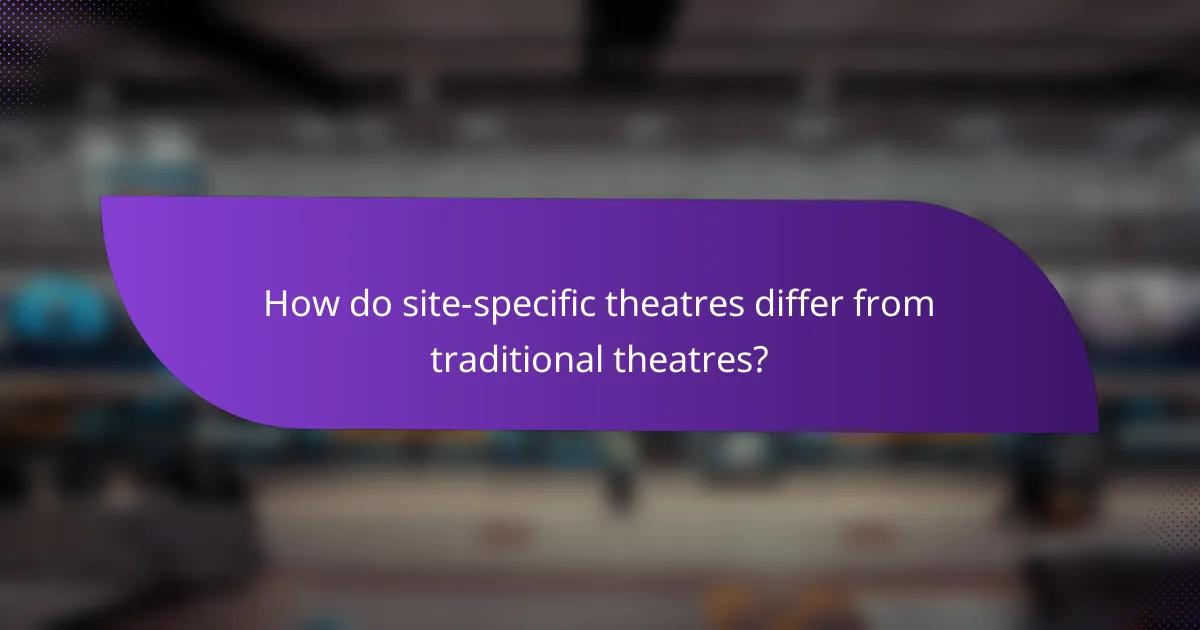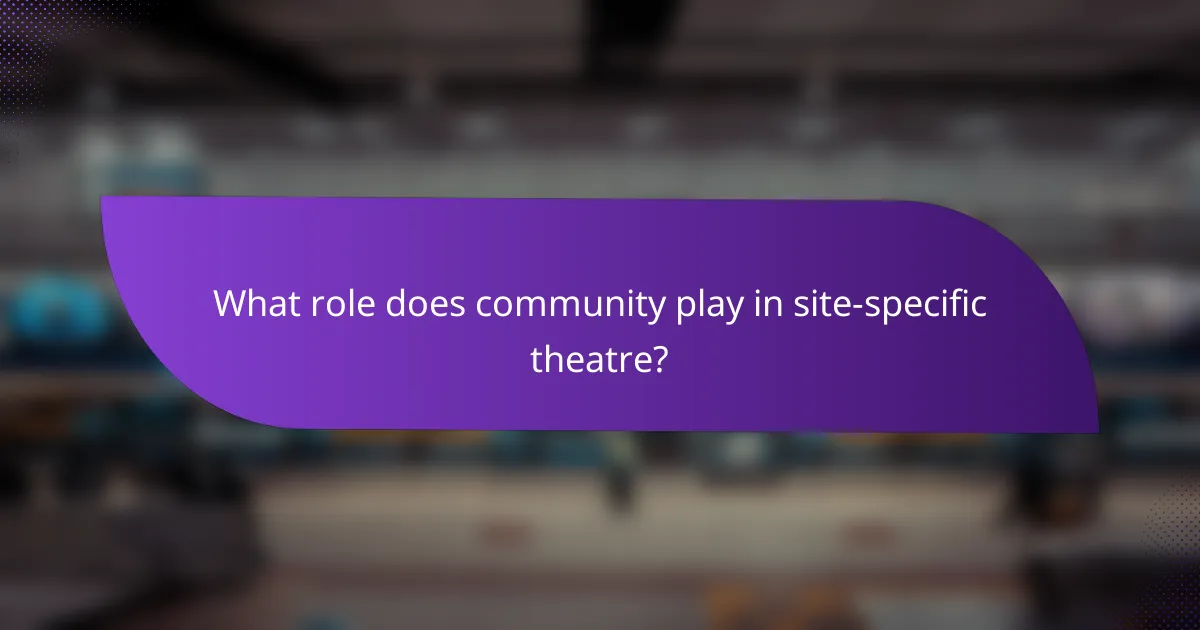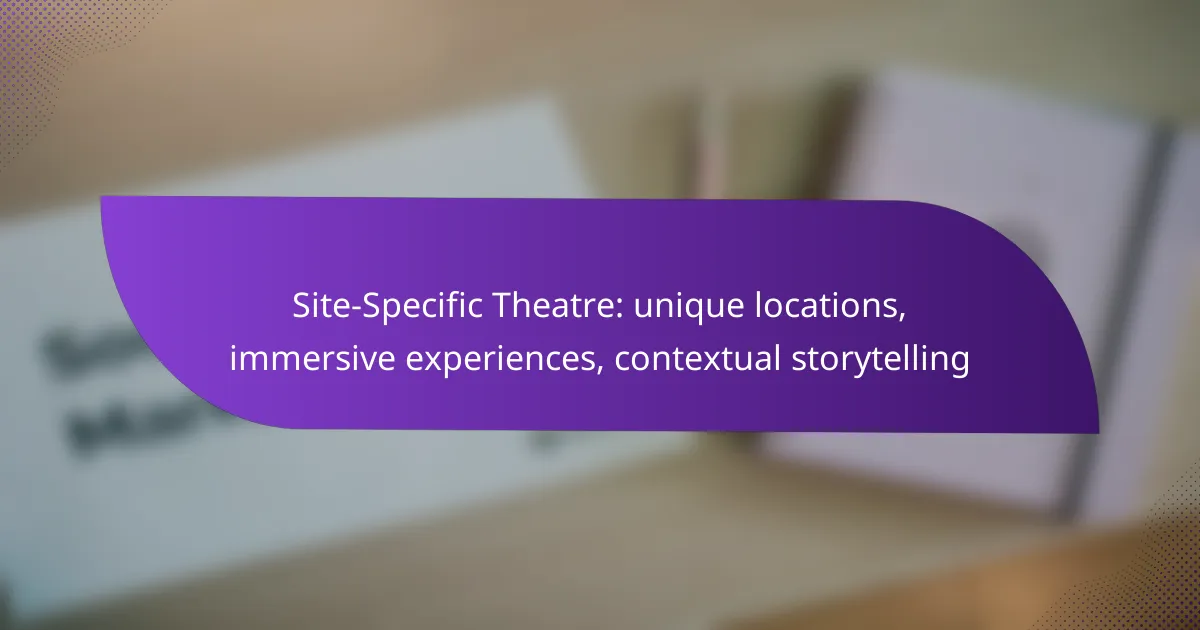Site-specific theatre transforms unique locations into dynamic storytelling spaces, creating immersive experiences that captivate audiences. By intertwining narratives with the historical and contextual significance of their surroundings, these performances invite spectators to engage actively with the story, deepening their emotional connection and understanding. In this way, the location becomes an essential character in the narrative, enriching the overall theatrical experience.

What are the best site-specific theatres in London?
London boasts several exceptional site-specific theatres that offer unique experiences by utilizing their surroundings to enhance storytelling. These venues create immersive environments that draw audiences into the narrative, making the location an integral part of the performance.
The Vaults
The Vaults, located beneath Waterloo Station, is renowned for its atmospheric setting and innovative productions. This former railway arch space is transformed into a playground for immersive theatre, often featuring interactive elements that invite audience participation.
Visitors can expect a diverse range of performances, from horror-themed shows to whimsical adaptations of classic tales. The venue’s flexibility allows for creative staging and unique interpretations, making each visit a fresh experience.
Shakespeare’s Globe
Shakespeare’s Globe is a reconstruction of the original Globe Theatre, where many of Shakespeare’s plays were performed. This open-air venue offers a historically rich environment, allowing audiences to experience the Bard’s works as they were intended, with the elements playing a role in the performance.
With standing tickets available at affordable prices, it attracts a wide audience. The Globe also hosts educational programs and workshops, enhancing its role as a cultural hub in London.
Wilton’s Music Hall
Wilton’s Music Hall is the world’s oldest surviving music hall, providing a charming and intimate setting for a variety of performances. Its rich history and unique architecture contribute to its appeal, making it a favorite among both locals and tourists.
The venue hosts a range of events, from theatrical productions to concerts, often showcasing emerging talent. Its commitment to preserving the heritage of performance art while embracing contemporary works makes Wilton’s a vital part of London’s cultural landscape.

How do immersive experiences enhance storytelling?
Immersive experiences enhance storytelling by actively engaging audiences in the narrative, allowing them to interact with the environment and characters. This involvement deepens their understanding and emotional investment in the story being told.
Engagement through interaction
Interaction is a key component of immersive experiences, as it invites audiences to participate rather than passively observe. This can include making choices that affect the storyline, exploring unique locations, or engaging with performers in real-time.
For example, in site-specific theatre, audiences might navigate through different rooms or outdoor spaces, discovering elements of the story in various contexts. This physical engagement can create a sense of agency, making the experience more memorable.
Emotional connection with the narrative
Immersive experiences foster a strong emotional connection by placing audiences directly within the story’s world. When participants feel they are part of the narrative, their emotional responses are often heightened, leading to a more profound connection with the characters and themes.
Consider a performance set in a historical location where the audience witnesses events unfold in the very space where they occurred. This contextual storytelling can evoke powerful feelings and reflections, enhancing the overall impact of the narrative.

What are the key elements of contextual storytelling?
Contextual storytelling involves creating narratives that are deeply intertwined with the specific location and circumstances of the performance. Key elements include the relevance of the location, its historical significance, and how these factors enhance the audience’s immersive experience.
Location relevance
Location relevance refers to how the chosen site enhances the story being told. A performance set in a historic building can evoke emotions and connections that a traditional theatre might not. For example, a play about a factory’s history performed in an actual factory can create a powerful atmosphere that resonates with the audience.
When selecting a location, consider its physical characteristics and how they relate to the narrative. Factors such as accessibility, ambiance, and the audience’s familiarity with the site can significantly impact the storytelling experience. Always ensure that the location complements the themes and emotions of the performance.
Historical significance
Historical significance involves the importance of the location’s past and how it informs the narrative. A site with a rich history can provide context that deepens the audience’s understanding of the story. For instance, a play about civil rights might be more impactful if staged in a historically relevant location, such as a former protest site.
To leverage historical significance effectively, research the site’s background and its connection to the themes of the performance. Highlighting key historical events or figures associated with the location can enhance the audience’s engagement. Always strive to create a narrative that honors the site’s history while weaving it seamlessly into the performance.

How do site-specific theatres differ from traditional theatres?
Site-specific theatres are distinct from traditional theatres primarily in their use of unique locations to enhance storytelling. Instead of a fixed stage, performances occur in various settings that are integral to the narrative, creating a more immersive experience for the audience.
Unique settings
Site-specific theatres utilize unconventional locations such as warehouses, parks, or historical buildings, allowing the environment to contribute to the story. This approach can transform everyday spaces into dramatic backdrops, making the setting a character in its own right.
For example, a performance set in an abandoned factory might incorporate the industrial elements into the plot, while a show in a botanical garden could use the natural surroundings to evoke themes of growth and decay. The choice of location often reflects the narrative’s themes, enhancing the overall impact.
Audience immersion
In site-specific theatre, audience immersion is a key element, as spectators often move through the performance space rather than being seated in a fixed position. This dynamic engagement allows viewers to experience the action from different perspectives, making them active participants in the storytelling process.
To enhance immersion, productions may encourage audiences to explore the space, interact with performers, or even influence the direction of the narrative. This level of involvement can lead to a more personal and memorable experience, as the audience feels a deeper connection to the story and its environment.

What are the challenges of site-specific theatre productions?
Site-specific theatre productions face several challenges, including logistical constraints and audience accessibility issues. These factors can significantly impact the overall success and experience of the performance.
Logistical constraints
Logistical constraints in site-specific theatre often involve the physical limitations of the chosen location. These can include restricted space, limited access to facilities, and the need for specialized equipment to adapt the performance to the environment.
For instance, a production set in an old warehouse may require additional safety measures, such as fire exits and crowd control, which can complicate planning. It’s crucial to conduct thorough site assessments to identify potential obstacles and ensure compliance with local regulations.
Audience accessibility
Audience accessibility is a significant concern for site-specific theatre, as not all locations are easily reachable or accommodating for diverse audiences. Factors such as transportation options, physical barriers, and seating arrangements can affect attendance and overall enjoyment.
To enhance accessibility, consider providing clear directions, offering transportation assistance, and ensuring that the venue meets accessibility standards, such as wheelchair access. Engaging with the community can also help identify specific needs and preferences, making the experience more inclusive.

What trends are emerging in site-specific theatre?
Emerging trends in site-specific theatre focus on enhancing audience engagement through innovative techniques and immersive storytelling. These trends include the integration of virtual reality and a strong emphasis on environmental storytelling, allowing for unique experiences that resonate with the specific location.
Virtual reality integration
Virtual reality (VR) integration in site-specific theatre creates immersive environments that transport audiences into the narrative. By using VR headsets, participants can explore settings that may be difficult to access physically, enhancing their emotional connection to the story.
When incorporating VR, consider the technical requirements and the audience’s comfort level with technology. A successful implementation often includes a balance between live performance and virtual elements, ensuring that the experience remains cohesive and engaging.
Environmental storytelling
Environmental storytelling leverages the unique characteristics of a location to enhance the narrative. This approach involves using the physical space to convey themes, emotions, and historical context, making the setting an integral part of the story.
To effectively utilize environmental storytelling, assess the location’s features and how they can be woven into the narrative. For instance, an abandoned factory can evoke themes of decay and resilience, while a lush park may symbolize growth and renewal. Engaging with the surroundings allows audiences to experience the story in a more profound way.

How can audiences find site-specific theatre experiences?
Audiences can discover site-specific theatre experiences through various channels, including online platforms and local theatre guides. These resources provide information about performances that take place in unique locations, enhancing the immersive experience for attendees.
Online platforms
Online platforms are a primary resource for finding site-specific theatre experiences. Websites like Eventbrite, Meetup, and local arts organizations often list upcoming performances, allowing users to filter by location, date, and type of event. Social media platforms, particularly Facebook and Instagram, can also be valuable for discovering events through community groups and event pages.
When searching online, consider subscribing to newsletters from local theatre companies or arts organizations. These newsletters frequently provide updates on unique performances and exclusive ticket offers, ensuring you stay informed about the latest site-specific events in your area.
Local theatre guides
Local theatre guides, often found in print or online, are excellent resources for discovering site-specific theatre experiences. These guides typically feature a curated list of performances, including details about the venue, ticket prices, and showtimes. They may also include reviews and recommendations, helping audiences make informed choices.
Check with local tourism offices or community centers, as they often distribute theatre guides or can recommend popular performances. Additionally, local newspapers frequently cover arts and culture, providing insights into upcoming site-specific shows that might not be widely advertised elsewhere.

What role does community play in site-specific theatre?
Community is central to site-specific theatre, as it fosters connections between the audience, performers, and the unique location. This form of theatre thrives on local narratives and cultural contexts, making the involvement of the community essential for authenticity and engagement.
Local engagement
Local engagement in site-specific theatre involves actively involving community members in the creative process. This can include casting local actors, gathering stories from residents, and utilizing familiar locations that resonate with the audience. Such involvement not only enhances the authenticity of the performance but also strengthens community ties.
To effectively engage the local community, theatre companies should consider hosting workshops or open forums where residents can share their experiences and ideas. This collaborative approach can lead to richer narratives and a more invested audience. For example, a performance set in a historic building could incorporate stories from locals who have personal connections to that space.
It’s crucial to approach local engagement with respect and sensitivity. Theatre makers should ensure that the stories told are representative and inclusive of diverse community voices. Avoiding stereotypes and seeking genuine collaboration can help build trust and foster a sense of ownership among community members.
